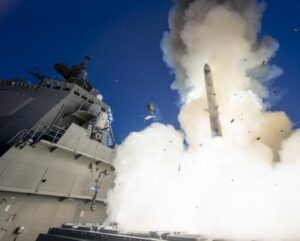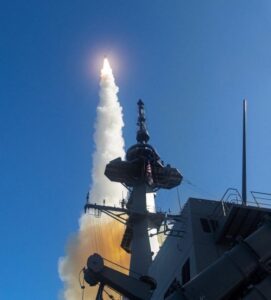The U.S. Missile Defense Agency (MDA), U.S. Navy and Japan Maritime Self-Defense Force (JMSDF) on Monday announced the first successful missile defense test firing of Standard Missile-3 missiles from Japanese destroyers off the coast of Hawaii.
The testing occurred over a two-week event with two live fire exercises, called Japan Flight Test Mission-07 (JFTM-07).

The first test on Nov. 16 had the Aegis-equipped guided-missile destroyer JS Maya (DDG-179) fire an SM-3 Block IIA missile against a T4-E target mimicking a medium-range ballistic missile (MRBM). MDA said the ship tracked and then fired on the target, successfully destroying it over the Pacific Ocean.
MDA said the second test, on Nov. 19, “demonstrated a successful integrated air and missile defense scenario” by using an SM-3 Block IV and SM-2 Block IIIB missiles fired from the destroyer JS Haguro (DDG-180) against an unspecified short-range ballistic missile (SRBM) target and an anti-air warfare engagement against a Kratos Defense BQM-177 target.
According to a JMSDF statement, the test occurred “in the vicinity of Hawaii” with the ballistic missile targets launched from the Navy Missile Range facility on Kauai. Both interceptors “successfully hit a target outside of the atmosphere.”
The Japanese government also noted this was the first time two Japanese warships conducted simultaneous SM-3 launch tests in the same period.
The SM-3 IIA model was developed in a co-development agreement between the U.S. and Japan. It has the space for more propulsion in the second stage and a larger kill vehicle so it can reach faster exit velocities and defend a larger area.
According to an MDA fact sheet, the agency uses T4-A, B, C and G targets as well as Pathfinder Zombies and Black Daggers for SRBM-type targets. The zombies use recycled rocket motors and other parts rather than new targets.
The fact sheet also said MRBM targets include T1, T2, T3, Subscale T4, T4-E, T4-Q, and T-5 systems. The T1 is a simple 621 – 1,056 mile range target, the T2 adds the ability for a “more complex scene” for missile defense testing, the T3 is a specialty target in the range that replicates an unspecified specific threat and the T4s “meet some of the medium range requirements. The T5 represents an “advanced threat.”
MDA underscored the testing period was a “significant milestone” in U.S.-Japan missile defense cooperation and the goal of JTFM-07 was to support the Japanese naval force’s ballistic missile defense modernization and certification of the Japanese Aegis Weapon System Baseline variant J7 as well as the Maya-class destroyer deployment.

“The success of this joint test marks a critical milestone in demonstrating, for the first time, a live fire of an SM-3 Blk IIA from a Japanese ship. The cooperative development of the SM-3 Blk IIA by the Japanese government, U.S. government and industry team, and the integration with the Aegis Weapon System on Japan’s Ballistic Missile Defense-capable ships, is a remarkable achievement and vitally important in defending against an ever-increasing threat,” MDA Director Vice Adm. Jon Hill said in a statement.
The agency also said this demonstrated the capability of SM-3 IIA to intercept MRBM and IRBM-range missiles.
In June, MDA awarded Raytheon Technologies [RTX] an $867 million contract to buy an unspecified number of SM-3 IIA All-Up-Round missiles for the U.S. and Japan, due to be ready by late 2026, (Defense Daily, June 15).
The agency’s fiscal year 2023 budget request asked for $1.6 billion for the Aegis missile defense system including 47 SM-3 Block IB and 10 SM-3 IIA missiles (Defense Daily, April 1).
In August, the MDA, U.S. Navy, and Japan verified a third successful demonstration of the J7.B Japanese variant of the Aegis software supporting the Japan Aegis System-Equipped Vessel program. Japan is set to field the J7.B software and Lockheed Martin [LMT] SPY-7(v)1 radar on Aegis-capable ships for missile defense purposes (Defense Daily, Sept. 13).
Japan is focusing on sea-based missile defenses after the government canceled plans in 2020 to use the Lockheed Martin SPY-7 Long Range Discrimination Radar on two Aegis Ashore sites due to technical and cost concerns in the face of local opposition (Defense Daily, June 29, 2020).